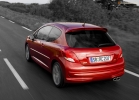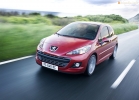technical characteristics of Peugeot 207 RC since 2007 hatchback
Technical characteristics of PEUGEOT 207 3 doors 2008, 2009, 2010, 2011, 2012, 2013: power, fuel consumption per 100 km, weight (mass), road clearance (clearance), radius of the turn, type of transmission and brakes, body size and tires
Engine characteristics
| Modifications |
Engine volume, cm3 |
Power, kW (lp)/about |
Cylinders |
Twisting, Nm/(rpm) |
Type of the fuel system |
Type of fuel |
| 1.6 16V Turbo |
1598 |
128(175)/5000 |
L4 (in -line location) |
240/1600 |
Multiple injection |
Petrol |
Drive and transmission
| Modifications |
type of drive |
Type of transmission (basic) |
Type of transmission (optionally) |
| 1.6 16V Turbo |
Front-wheel drive |
5-MKPP |
|
Brake system and steering wheel amplifier
| Modifications |
Type of front brakes |
Type of rear brakes |
Power steering |
| 1.6 16V Turbo |
Ventilated discs |
Disk |
there is |
The size of the tires
| Modifications |
The size |
| 1.6 16V Turbo |
205/45R17 |
Dimensions
| Modifications |
Length, mm |
Width, mm |
Height, mm |
The track front/back, mm |
Wheel base, mm |
Road clearance (clearance), mm |
Trunk volume, l |
| 1.6 16V Turbo |
4031 |
1750 |
1471 |
1471/1471 |
2540 |
- |
- |
Car weight
| Modifications |
Equipped mass, kg |
Maximum mass, kg |
Lifting capacity, kg |
| 1.6 16V Turbo |
1225 |
1700 |
475 |
Dynamics
| Modifications |
Maximum speed, km/h |
Acceleration time to 100 km/h, with |
CD (frontal resistance coefficient) |
| 1.6 16V Turbo |
220 |
7.1 |
- |
Fuel consumption
| Modifications |
In the city, l/100 km |
On the highway, l/100 km |
Average consumption, l/100 km |
Extrication CO2, g/km |
Type of fuel |
| 1.6 16V Turbo |
9.9 |
5.5 |
7.2 |
171 |
Petrol |






